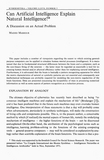Article
Full entry |
 PDF
(0.5 MB)
Feedback
PDF
(0.5 MB)
Feedback
 PDF
(0.5 MB)
Feedback
PDF
(0.5 MB)
Feedback
References:
[1] Amosov N. M.: Modeling of thinking and the mind. Spartan Books, New York 1967.
[2] Attneave F.: Applications of information theory to psychology. Holt, New York 1959.
[3] Boulanger G. R.: Artificial intelligence. In: J. Rose (Ed.): Progress of cybernetics. Vol. 1. Gordon and Breach, London 1970. MR 0269330
[4] Evans G. E.: A program for the solution of a glass of geometric-analogy intelligence-test questions. In: M. Minsky (Ed.): Semantic information processing. The MIT Press, Cambridge 1968.
[5] Fitts P. M., Posner M. I.: Human performance. Books/Cole, Belmont 1967.
[6] Guilford J. P.: Psychometric methods. McGraw-Hill, New York 1954.
[7] Hunt E. B.: What kind of computer is man?. Cognitive Psychology 2 (1970), 57-98.
[8] Jacobson H.: The informational capacity of the human eye. Science 113 (1951) 292-293.
[9] Mashour M.: Psychophysical relations in the perception of velocity. Almqvist & Wiksell, Stockholm 1964.
[10] Mashour M., Hosman J.: On the new "psychophysical law" - a validation study. Perception & Psychophysics 3 (1968), 367-375.
[11] Mashour M.: The rate of visual perception of moving patterns. In: H. Drischel and N. Tiedt (Eds.): Biokybernetik. Band III. VEB Gustav Fischer Verlag, Jena 1971.
[12] Miller G. A.: The magical number seven plus or minus two: Some limits on our capacity for processing information. Psychological Review 63 (1956), 81-97.
[13] Minsky M.: Semantic information processing. The MIT Press, Cambridge 1968. Zbl 0187.13301
[14] Young J. F.: Cybernetics. Iliffe Books Ltd., London 1969.

